#the emperor of the North Pole
Text
The happiest of birthdays in the afterlife to Lee Marvin! Truly one of the best to ever do it!




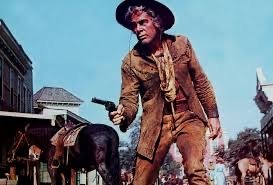

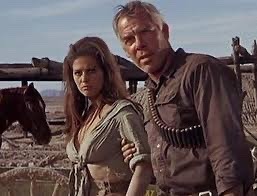
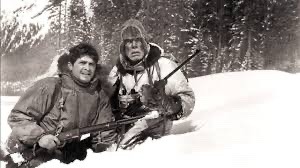

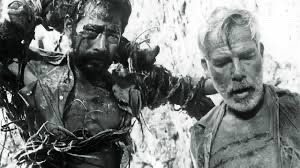
#Lee Marvin#point blank#the dirty dozen#hell in the pacific#death hunt#Gorky park#the delta force#I the wild one#the big heat#cat ballou#the killers#the big red one#the professionls#avalanche express#prime cut#the man who shot liberty valance#Monte Walsh#the emperor of the North Pole
4 notes
·
View notes
Text

How Hadrian’s Wall is Revealing a Hidden Side of Roman History
A party invitation. A broken flipflop. A wig. Letters of complaint about road conditions, and an urgent request for more beer.
It sounds like the aftermath of a successful spring break, but these items are nearly 2,000 years old.
They’re just some of the finds from Hadrian’s Wall – the 73-mile stone wall built as the northwestern boundary of the Roman Empire, sealing off Britannia (modern-day England and Wales) from Caledonia (essentially today’s Scotland).
While most of us think of Pompeii and Herculaneum if we’re thinking of everyday objects preserved from ancient Rome, this outpost in the wild north of the empire is home to some of the most extraordinary finds.
“It’s a very dramatic stamp on the countryside – there’s nothing more redolent of saying you’re entering the Roman empire than seeing that structure,” says Richard Abdy, lead curator of the British Museum’s current exhibition, Legion, which spotlights the everyday life of Roman soldiers, showcasing many finds from Hadrian’s Wall in the process. A tenth of the Roman army was based in Britain, and that makes the wall a great source of military material, he says.
But it’s not all about the soldiers, as excavations are showing.
A multicultural melting pot
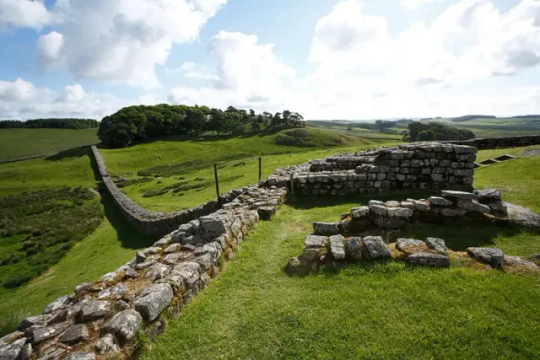
Hadrian, who ordered the wall to be built in 122CE after a visit to Britannia, had a different vision of empire than his predecessors, says Frances McIntosh, curator for English Heritage’s 34 sites along Hadrian’s Wall.
“All the emperors before him were about expanding the empire, but Hadrian was known as the consolidator,” she says. He relinquished some of the territory acquired by his predecessor Trajan, and “decided to set the borders” – literally, in some cases, with wooden poles at sites in Germany, or with stone in Britannia. Where those poles rotted thousands of years ago, the wall is still standing: “A great visual reminder” of the Roman empire, says McIntosh.
It’s not just a wall. There’s a castle every mile along, and turrets at every third-of-a-mile point, with ditches and banks both north and south. “You can imagine the kind of impact that would have had, not just on the landscape but on the people living in the area,” says McIntosh.
And thanks to the finds from the wall, we know a surprising amount about those people.
Although historians have long thought of army outposts as remote, male-dominant places, the excavations along the wall show that’s not the case. Not only were soldiers accompanied by their families, but civilians would settle around the settlements to do business. “ You can almost see Housesteads as a garrison town,” says McIntosh. “There were places you could go for a drink and so on.”
The Roman rule of thumb was not to post soldiers in the place they came from, because of the risk of rebellion. That meant Hadrian’s Wall was a cultural melting point, with cohorts from modern-day Netherlands, Spain, Romania, Algeria, Iraq, Syria – and more. “It was possibly more multicultural because it was a focus point,” says McIntosh, who says that the surrounding community might have included traders from across the empire.
Soldiers were split into two groups. Legionaries were Roman citizens from Italy, who had more rights than other soldiers and imported olive oil, wine and garum (a sauce made from decomposing fish).
They worked alongside auxiliaries – soldiers from conquered provinces, who had fewer rights, but could usually acquire citizenship after 25 years of service.
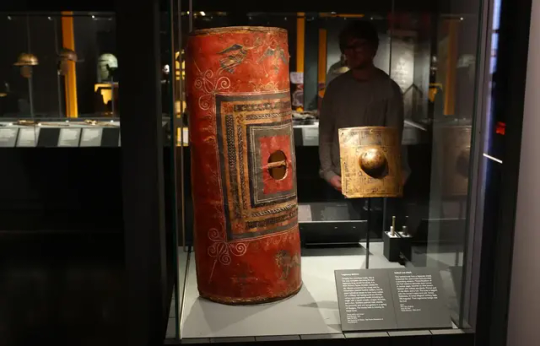
Soldiers carved their names and regiments on stones to show which part of the wall they built – around 50 of them are on display at Chesters fort.
But the wall shows that women and children were equally present.
McIntosh says that pottery brought to the camps – from the Low Countries and North Africa – shows that the soldiers “brought their families, who cooked in traditional style.” Archaeologists have found what seems to be an ancient tagine for North African-style cooking.
A tombstone from Arbeia fort for a woman named Regina shows she was a freed slave from southern Britain who was bought by – and married to – a Syrian soldier.
Another woman buried at Birdoswald fort was laid to rest with chainmail that appears to be from modern-day Poland. “Perhaps she married someone in the army,” says McIntosh, who calls the wall a “melting pot of people from all over the world under the banner of the army.”
“They brought their own religions, as well as worshipping Roman gods and adopting local deities,” she adds. At Carrawburgh, a temple to Mithras – an originally Persian deity – sat near a spring with a shrine to a local water spirit.
‘Wretched little Brits’

Some of the most extraordinary finds from the Roman empire are coming from one site on Hadrian’s Wall: Vindolanda. Here, archaeologists have found a wealth of organic remains because of what curator Barbara Birley calls the “unusual conditions onsite.”
At Vindolanda there are the remains of at least nine forts over 14 levels. “When the Romans would leave, they would knock down timber forts, and cover the area with turf and clay, sealing the layers underneath,” she says.
“Because it happened so many times, the bottom five or six layers are sealed in anaerobic conditions, so things don’t decay. When we get down there, we get wooden objects, textiles, anything organic.”
Vindolanda has the largest collection of Roman textiles from a single site in western Europe, as well as the largest leather collection of any site in the Roman empire – including 5,000 shoes, and even a broken leather flip-flop. “We probably had a population of 3,000 to 6,000 depending on the period, so 5,000 is a lot,” says Birley. For Abdy, the shoes evoke the conditions of the wet borderlands. “Women’s and children’s shoes are hobnailed – you needed it in the mucky frontier dirt tracks. They’re very evocative.”
There’s even a wig made from a local plant, hair moss, which is said to repel midges – the scourge of Scotland during the summer. A centurion’s helmet is also crested with hairmoss – the ancient equivalent of spraying yourself with insect repellent.
The first woman to write in Latin

One of the most famous finds is the trove of wooden writing tablets – the largest found anywhere.
“They give a snapshot of what life was actually like,” says Birley. “We understand so much more from written correspondence than from ‘stuff,’ and, archaeologically, it’s the stuff that usually survives – things like metals and ceramics.
“These were written in ink, not on a wax stylus tablet, and we believe they were used for what we’d put in emails: ‘The roads are awful,’ ‘The soldiers need more beer.’ Everyday business.”
The tablets – or “personal letters” as Birley describes them – were found on the site of a bonfire when the ninth cohort of Batavians (in the modern-day Netherlands) were told to move on.
“They had a huge bonfire and lots of letters were chucked in the fire. Some have been singed – we think it may have rained,” she says. One of them calls the locals “Britunculi” – “wretched little Brits.” Another talks about an outbreak of pinkeye. One claims that the roads are too bad to send wagons; another laments that the soldiers have run out of beer.

Among the 1,700 letters are 20 that mention a woman called Sulpicia Lepidina. She was the wife of the commander of the garrison, and seems to have played a crucial role. There’s a letter to her from another woman, Paterna, agreeing to send her two medicines, one a fever cure.
Birley says it’s similar to today. “If you’re a group of moms, still today we say, ‘Do you have the Calpol?’ It’s very human.” For Abdy, it’s a sign that women were traders. “She’s clearly flogging her medicines,” he says. “It’s really great stuff.”
Another tablet is an invite from Claudia Severa, the wife of another commander at a nearby camp. It’s an invitation to a birthday party. Under the formal invitation, presumably written by a scribe, is a scrawl in another hand: “I shall expect you, sister. Farewell, sister, my dearest soul.”
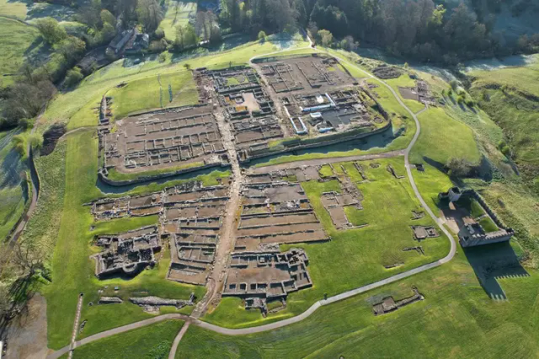
Presumably written by Claudia herself, it is thought to be the earliest example of a woman’s handwriting in Latin.
Without the organic finds – the shoes and the letters that indisputably belonged to women, unlike jewellery or weaving equipment – it’s difficult to prove conclusively that women lived in significant numbers. Vindolanda “illustrate the missing gaps,” says Abdy.
For Birley, they prove that women were as crucial a part of army communities as men. “Before the Lepidina tablets were found we didn’t really understand the interactions between the soldiers and their wives,” she says. Another tablet is written by what is thought to be a Spanish standard-bearer’s common-law wife, ordering military equipment for her partner.
“The Vindolanda collection is showing that there weren’t just camp followers and prostitutes; women were part of everyday life, and contributing to the military community in many ways,” says Birley.
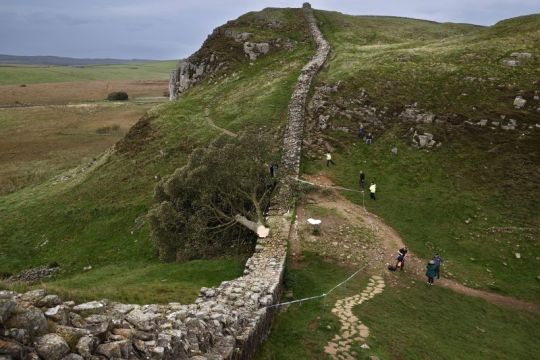

Abdy says that Hadrian’s Wall is interesting because the resident women span “all classes of society,” from Regina – the dead freedwoman, who would have been “bottom of the heap” – to the trader Paterna and the noblewoman Lepidina.
And of course, there’s the wall itself.
“In the Netherlands and Germany the finds are often stunning and better preserved – you go to museums and are bowled over. But in terms of structural remains, Hadrian’s Wall must be among the best,” says McIntosh, modestly, of her site.
Abdy agrees: “I can’t think of many symbols so redolent of imperial will than that wall.”
By Julia Buckley.
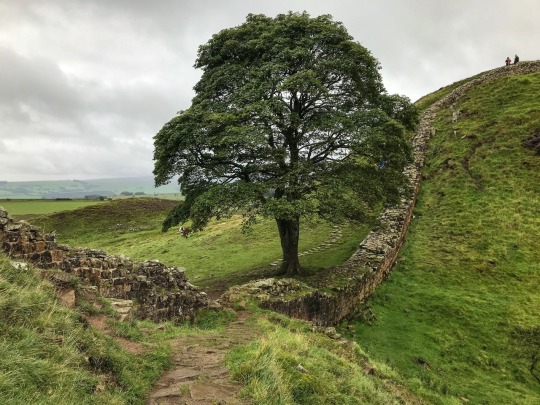
#How Hadrian’s Wall is Revealing a Hidden Side of Roman History#Hadrian’s Wall#emperor hadrian#northwestern boundary of the Roman Empire#Britannia#Caledonia#roman legions#ancient artifacts#archeology#archeolgst#history#history news#ancient history#ancient culture#ancient civilizations#roman history#roman empire#long post#long reads
110 notes
·
View notes
Text
Wet Beast Wednesday: emperor penguin
This is the last Wet Beast Wednesday before Christmas and Christmas is associated with the north pole thanks to Santa. So to celebrate the season, I'm going about as far away from the north pole as it is possible to go and talking about the emperor penguin. This also happens to be the first dinosaur I've showcased on this series.
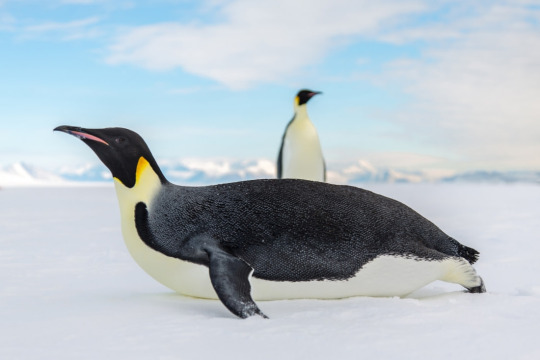
(image id: an emperor penguin lying belly-down on ice, seen from the side. Its back, wings, and head are black while its belly and neck are white. It has a patch of orange feathers near the ears. Another penguin is standing up in the background. end id)
Aptenodytes forsteri is the largest of all penguins and the sixth largest (by weight) bird in the world, only surpassed by the emu and two species each of the cassowary and ostrich. Those are all paleognaths, one of two living groups of birds, making the emperor penguin the largest of the other group: the neognaths. There are some discrepancies on their size due to the standards of bird measurement, but recent measurements list their standing height as reaching 120 cm (3.9 ft) with a weight of 22.7 to 45.4 kg (50 to 100 lbs). Their weight varies a lot during their lives, with both males and females losing a lot of weight during breeding season. Males generally weigh more than females. Genomic and anatomical analysis indicates that the emperor penguin, along with the closely-related king penguin and an extinct species, are part of a group of penguins that branched off of the family tree before the other living penguin species. As with other penguin species, they are heavily adapted for life in the water. All penguins are flightless, with their wings having adapted into flippers used for swimming. Penguins stand differently than other birds. Most birds have long legs and hold their bodies horizontally to the ground or at an angle, but penguins have short legs and hold their bodies vertically, like humans do. This, plus other adaptations, helps streamline the birds, letting them swim more efficiently. Like other seabirds, their feathers are very dense and coated with oil that repels water. This keeps the feathers from becoming waterlogged, reducing drag and helping keep the bird warm. During molting season, the feathers emerge from the skin mostly formed and push out the old feathers, preventing the penguin from developing bald or thin patched that would compromise insulation. While the feathers are responsible for most of the insulation, a layer of fat also helps. Like other birds, penguins are endothermic, commonly known as warm-blooded. Penguin tongues have backward-pointing barbs that help prevent food from escaping their mouths.

(image id: an emperor penguin jumping out of the water and onto ice. It is pictured in midair with its body roughly parallel to the ground and wings extended. Multiple other penguins are in the background. end id)
Emperor penguin's divide their year between the breeding season and the rest of their lives. During most of the year, they spend their time searching for food. Most of this food consists of fish, krill, and squid. Emperor penguins are social animals that often coordinate with each other to hunt in groups. While hunting, they will dive up to 535 meters (1,755 ft) and spend up to 21 minutes underwater before surfacing to breathe. During dives, the pressure can increase up to 40 times and the emperor penguin has some special adaptations to cope. Unlike most birds, emperor penguin bones are solid, reducing the chance of one breaking under pressure. During dives, the heartbeat slows dramatically and non-essential organs cease functioning to conserve oxygen in the blood. In addition, the hemoglobin in the red blood cells is modified to carry more oxygen in high pressure and low temperature. While on land, emperor penguins gather in colonies along the shoreline. Members of the colonies spend a lot of them time huddled against each other to keep warm. The penguins live all around Antarctica between 66 and 77 degrees southern latitude.
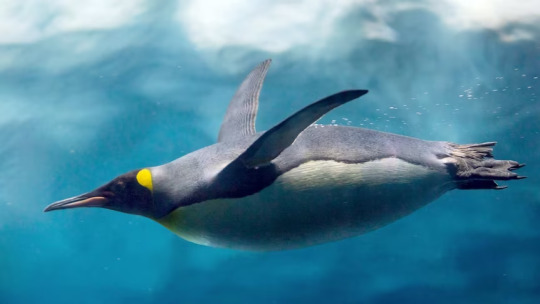
(image: an emperor penguin swimming underwater. Its head is pointed up, making its body very streamlines. Its wings are extended and are used for propulsion and steering. end id)
The thing emperor penguins are most famous for is their breeding behavior. Breeding season starts at the beginning of winter in Antarctica, between March and April, and is triggered by the decrease in day length. Penguin colonies travel inland en masse moving between 50 and 120 km (31 to 75 miles) to find a spot to raise their chicks. These spots are usually large, flat patches of sea or lake ice with a barrier such as a cliff or iceberg used to block the wind. Males perform sexual displays wherein they make loud courtship calls while wandering around the colony. When a female is interested, she will face they male and they will both hold their heads up for a few minutes. Once a pair os formed, they will walk around the colony together. When ready to mate, The pair will bow to each other. Emperor penguins are serially monogamous. They will only mate with one other penguin each season, but rarely pick the same mate more than once. The pair say together until the egg is laid in late May or early June. The female then transfers the egg (only one is laid every year) to the male, a tricky process. They have to use their feet to transfer the egg without dropping it. If the egg breaks or is exposed to the ice for more than a minute or so, it will die. It is not uncommon for an egg to be lost, especially in first-time parents. If this happens, both parents will leave the colony and return to the sea, not mating again until next year. The male balances the egg on his feet and covers it with a loose flap of skin. The bottom of this skin is a featherless patch called the brood patch that only forms during this season. By keeping the egg between his feet and the brood patch, the male incubates it. Once the egg is transferred, the female returns to the sea, leaving the male responsible for the next few months. In every other penguin species, the mother and father take turns incubating their egg. for the next 65-75 days, the male will incubate the egg in the middle of the Antarctic winter, where storms are frequent and temperatures can can reach into the -60s C (-70s F). He will not eat at all during this period, which, including travel and mating time, can last for 120 days. Males can lose up to half of their body mass during this fast. If the egg is dropped even once, it has a very high chance of dying. Walking without dropping the egg is tricky, but the males will form tight bunches to conserve body heat. These bunches are mobile, with members to the outside gradually moving inward and vice-versa. The egg usually hatches after around 60 days and it can take a few days to break out of its shell, which is thicker than in most bird species. The chicks are born featherless and will freeze to death if they leave the male's brood pouch. The male produces a substance called crop milk with a gland in his esophagus. Crop milk is unique to pigeons, flamingos, and male emperor penguins and is used to feed the chick. The crop milk does not provide full nourishment to the chick, but will keep it alive for about a week.
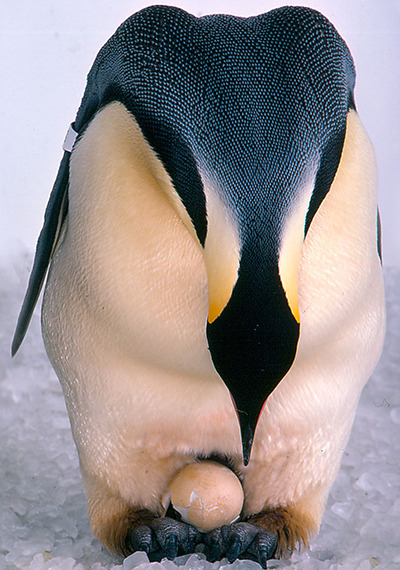
(image id: a male emperor penguin standing on ice with its egg balanced on its feet. The skin flap thet normally covers the egg is pulled back and the male is bending over to examine the egg. This egg is broken, possibly the result of being dropped, and is non-viable. end id)

(image id: a newly-hatched emperor penguin sitting on it's father's feet. It is very small and featherless, with grey skin and a black head. end id)
About this time, the female will return from her time at sea. She spent this time feeding and fattening herself up for the next leg of the parenting journey. She returns to the colony usually between 5 and 10 days after the hatching. If she arrives too late, the chick will starve. Once she arrives, she will locate her mate through the sound of his calls. The male then transfers the chick to the female's brood pouch and returns to the sea to feed and put weight on for another 3-4 weeks. The female will feed the chick by regurgitating half-digested food into its mouth. After this, the mother and father will take turns brooding the chick and feeding at sea. If either parent is delayed or dies, the chick will die as the remaining parent will eventually abandon it and return to sea. Orphaned chicks will try to seek food and shelter from other adults and mothers who have lost a chick may try to adopt an abandoned one, but as a single parent cannot raise a chick alone, it will eventually be abandoned as the adult goes to feed. Sometimes, a mother who lost her chick will attempt to steal a chick from another mother. This leads to fights over chicks that may leave chick trampled to death.
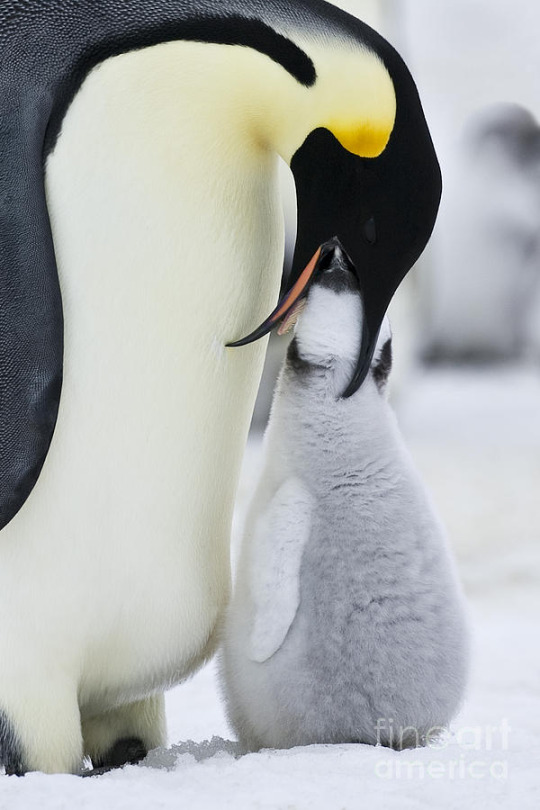
(image id: an adult emperor penguin feeding its chick. The chick is larger and covered in fluffy, grey, downy feathers. It no longer needs to stay on its parent's feet. The adult is looking down at the chick with its mouth open. The chick has its head inside the adult's mouth. end id)
Starting 45-50 days after hatching, the chicks now have a thick enough coat of down to survive outside of the brood pouch. Starting around this time, both parents will return to the sea and occasionally return to bring food, using the sound of their chick's vocalizations to track them down. When the parents are gone, the chick huddle together for warmth. Starting in early November, the chicks will start gaining their adult plumage and the adults will stop returning to feed them. Once they get hungry enough, the chicks will make the trip to the sea (which is shorter now as it is summer in the Antarctic and the sea ice has receded) and will be independent from now on. Only 15% of chicks survive their first year, but after that the survival rate is 95%, meaning most living emperor penguins are adults. Emperor penguins reach sexual maturity at 3 years, but most do not mate until they are 4-6 years old. The average lifespan of those who live long enough to reach adulthood is 20 years, but may live up to 50 years. The high survival rate of adults is in part due to a lack of predators. Adult emperor penguins are only hunted by leopard seals and orcas, though the former prefer juveniles. Juveniles are preyed upon by seals when they reach the water and by southern great petrels when on the ice. Adult emperor penguins lack any land predators, which has resulted in them having no prey response when on land. Scientists and antarctic explorers have reported that adults will approach them without fear.
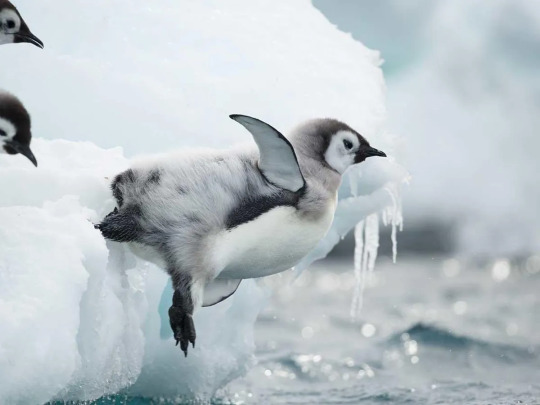
(image id: a newly-independent chick entering the water for the first time. It has not yet fully developed its adult plumage and has a mix of the chick's fluffy down and an adult's smoother coat. It is jumping off a ledge of ice into the water. Two other chicks watch from the side of the image. end id)
Emperor penguins are classified as near threatened by the IUCN, meaning they are losing population and may slip down into threatened status if conservation measures are not taken. The largest threat to emperor penguins is global warming reducing their habitat. Because they need sea ice to lay eggs and brood, the loss of sea ice every year has reduced the ability of the penguins to reproduce. in 2022, loss of sea ice led to a catastrophic failure to reproduce among nearly all known colonies. It is now estimated that 90% of colonies are at risk of dying out due to the loss of sea ice. If these trends are not reverted by reduction of global warming, the penguins could face extinction.

(Image id: two emperor penguins with their chick. The adults are standing behind the chick, which has its downy juvenile plumage. The chick stands about half the height of the parents. end id)
#wet beast wednesday#emperor penguin#penguin#marine biology#biology#zoology#ecology#animal facts#marine life#good parenting#cute#image description
123 notes
·
View notes
Text
Dragon Ball Z/Super: Comparing and contrasting Goku and Zamasu— two sides of the same coin? (Long post full of yapping!)
The Goku Black arc consistently portrays Black/Zamasu to be ideological parallels to Trunks for obvious reasons (Hope vs Despair, Selfishness vs Selflessness, he's the protagonist of this arc, etc.), but I think it's an interesting exercise to compare Zamasu's journey to Goku's. In my opinion, it really hammers in why Zamasu failed to reach enlightenment and fell from grace besides "mortals = stupid and barbaric" and plain old narcissism.


Everyone knows Goku's story by now, but I want to hone in on the part that I believe Zamasu's own parallels.
The beginning of Z features Goku gradually being introduced to entirely new realms of power and scale. He has to team up with the guy he worked his ass off to defeat 5 years ago just to barely defeat Raditz, a mid class Saiyan, sacrificing his own life in the process.

He is informed constantly by Vegeta that he is nothing but low-class scum, born at the bottom of the interplanetary Saiyan "totem pole", compared to Vegeta's own super-elite-royalty-goodness.

Then, by Namek, he manages to surpass Vegeta, and even trounces the emperor of the universe who subjugated the entire Saiyan race. After Namek, Goku grows so much that the conceptions of "class" that he was blindsided by quickly become faint memories, only brief blips in his life's work to always get stronger.
Not to be the strongest, or even to become "the strongest Saiyan who ever lived", simply to get stronger. Goku's goal is forever ongoing; he will never feel as if his duty is complete. If it ever was, he'd be restless and unsatisfied.
The key thread throughout the Saiyan and Frieza Sagas is that Goku never uses the labels ascribed to him or his opponents as anything more than momentary benchmarks in service of his overarching, everlasting goal to achieve more and more strength. He does not hear Vegeta's boasts about his status and go "okay, guess I'll be good enough once I can beat Vegeta in a 1 on 1, since I'll basically be a super elite!". He hears King Kai's fervent warnings about Frieza's terrible strength and gets curious rather than demotivated.


He doesn't use either of these as an excuse to run away or quit training.

In fact, Goku never uses anything as an excuse. He is not married to any sort of arbitrary benchmark of strength (that honor goes to Chi Chi), even in Super as he gains power that rivals Gods of Destruction.
To treat a level of strength, or a class (God of Destruction, Angel, Super Elite, Emperor of the Universe) as a stopping point for Goku or some sort of ultimate goal would imply that Goku's desire for strength has a defined end. But it doesn't, and so Goku doesn't put much stock into those things. He never loses sight of his goal, and he literally doesn't even stop training when he's dead.

As for Zamasu, the beginning of his journey is why I thought to juxtapose him with Goku in the first place. He shares a surprising similarity with early Z Goku, in that both were able to achieve greater statuses than their birth would afford them.
Zamasu started off as a normal Kai, the guardian of a universal quadrant (the North, same as King Kai). In terms of Dragon Ball's divine hierarchy, this is actually quite the low standing. It is the second lowest known class of Gods, only ranking above planetary deities like Kami and Dende. If a Core Person (Kai race) is born from a rare, special golden fruit, only then will they be qualified enough to train to be a Supreme Kai.
Zamasu is the only known canon example of a normal Kai being selected to become a Supreme Kai, and so his exceptional ascension up the divine hierarchy is a natural parallel to Goku's own defiance of his low-class nature and his comparatively low power level at birth.

Unlike Goku, however, Zamasu is absolutely obsessed with and bound by certain labels, which ultimately leads to his ideological downfall.
Firstly, we can see his fixation on the idea of godhood when he speaks to Gowasu.


When Gowasu simply tells him to temper himself and observe mortals, he immediately begins focusing on and belittling the gods' philosophy, almost outright saying "what the gods think does NOT align with justice". The way he phrases these sentences in both the dub and sub is key: he says "I thought you'd teach me justice, but...", which creates a juxtaposition between "divinity" and "REAL justice".

He even begins to doubt that a god could be considered a god if they did not align with his definition of justice.
Zamasu is young and inexperienced for a Kai (especially considering regular Kais have far shorter biological lifespans than Supreme Kais), so the reactions he displays in this scene suggest that he had a very romanticized, linear view of both godhood and justice. When Gowasu's statement suggests to Zamasu that he can't reconcile the two, it basically calls out all that Zamasu currently stands for, and he doesn't take it well.


Gowasu ends the discussion by challenging Zamasu's narrowminded belief that gods are "absolute" and perfect, but by then the two are already unable to get through to one another.
If you look at the other gods in Dragon Ball, you'll see what Gowasu means here. For example, Beerus is lazy, temperamental, and childish; none of the other gods really like him. Elder Kai is a lecher. Champa is rather undignified and just as temperamental as Beerus.



Where Goku seeks strength, Zamasu seeks virtue. Yet, unlike Goku, Zamasu has an arbitrary benchmark at where his objective stops: the abstract concept of "godhood".
When Zamasu reaches that endpoint and finds that it's not all it's cracked up to be, he constantly contorts his definition of divinity to match it— or rather, to match himself— rather than accepting that being a god is not equivalent to having a "perfect" sense of justice, or being "perfect" in general. He commits barbaric, brutal, bloodthirsty, and wanton acts, all in the name of "divine justice", despite those things being less becoming of gods and more becoming of mortals.



The dilemma extends to the very end of the arc, where in the dub Corrupted Merged Zamasu says to Vegetto: "If one can't control a world, one can't be called a god of it", instantly justifying his hypocrisy, his sadism, his violence, and his arrogance instead of looking inward and asking himself what it meant to be a god.
Like Gowasu said, Zamasu was "obsessed with the contradictions of gods and mortals", and as Trunks said, "it isn't about gods or mortals". Zamasu was so enamored with the idea and label of godhood, yet did not question whether or not his values, the values of his future counterpart, or the values of the other gods aligned with it. And how could he have questioned it if he didn't truly know what godhood meant himself— if he just used the idea as a synonym for what he believed?

Where Goku saw arbitrary labels as inconsequential to his overarching quest, Zamasu saw his life be entirely dictated by them. Zamasu allowed himself to be entrenched in the god-mortal dichotomy, whereas Goku's nature would never allow him to lose his big-picture goal like that.
When Goku's reality is challenged, whether by the introduction of some groundless measure of value (power level, Saiyan class) or by a vastly stronger opponent, he doesn't flinch. He doesn't stop. He doesn't make excuses. His overall goal doesn't change.
When Zamasu's reality was challenged, he broke and became everything he hated. He bent and twisted the rules of what he considered "just", and shattered the natural divine order by doing away with all Gods of Destruction. His goal, by then, was unrecognizable compared to his previous goal to be a benevolent Supreme Kai.
Where Goku's triumphs led him to continue being diligent and humble, Zamasu's own led him to be stagnant and arrogant. Even though Zamasu was proactive and cunning, he was stagnant in the sense that none of what he did made him more moral or virtuous, or gave him a greater understanding of the universe, even though those were the things he originally sought when studying under Gowasu.
All he did was further embed himself (literally, with Future Zamasu) within his own radical beliefs; he never progressed towards his original goal because he replaced it with "I am THE God, no more gods are needed, I will exterminate all mortals personally". His arrogance and inability to see gods as flawed beings made him lose the plot.
Goku continued working hard and getting stronger after vanquishing Frieza, whereas Zamasu's entitlement made him become a complete shell of himself.
Goku saw his growth from low-class warrior to Legendary Super Saiyan to be a testament to everything he stood for; the desire to protect and avenge his friends, his inherited Saiyan pride from Vegeta, and most importantly, his neverending journey to get stronger. Zamasu saw his ascension from North Kai to Supreme Kai as an excuse. A stopping point. An "okay, I've reached the pinnacle of the virtue I seek", refusing to accept that there was more beyond the arbitrary value and moral standing he placed on the role of a god, refusing to think mortals could ever possibly learn, and refusing to think gods could ever need to learn.

Zamasu is a dark reflection of Goku— Son Goku is everything that Zamasu is not. Zamasu is the opposite of many reasons that Goku is such a distinct and unique character, and that makes both of them all the more compelling.
22 notes
·
View notes
Text
Thought I had written this idea up before but apparently I didn't. (Because I didn't have much of a plot/set up to jazz it up I suppose?) But I remembered the worldbuilding element again when Shiro on discord was talking about the #Shen Yuan is born as Tywin Lannister's eldest son AU:

Okay so on Earth, the "North" can be referencing Canada, Russia, Scandinavian land and more. It's huge. More importantly, the planet is ROUND (no flat earthers on my timeline thank you very much).
We know one side of Mobei Jun's Northern Empire is Luo Binghe's Southern Demon Empire. What happens when Mobei Jun crosses the North Pole of his territory to the other side of the globe? What lands are those?
Hm... Westeros? >.>
So let's toss it into Shen Yuan is born as Tywin Lannister's eldest son AU. The Shen Qingqiu body died in an explosion and the Sun and Moon seeds (if that's the wrong name, well it's midnight here and I'm sleepy) kind of did its thing but not really and Shen Yuan gets an actual human body... in Joanna Lannister's womb. Maybe she ate some weird new plant that a merchant was introducing to the Westerland lord in hopes of getting a trade deal going with the very wealthy Casterly Rock which SURELY would love exotic plants to eat.
Anyways, this is all to say that Luo Binghe's hunt for his shizun won't have to involve going to other dimensions now. Mobei Jun calls up his demon overlord emperor to help the North solve a growing problem with some weird monsters cropping up in its most remote territory (aka the white walkers). Lo and behold, Luo Binghe learns of another human kingdom.
Plus with this twist to PIDW geography, Cang Qiong can join in the ride and fun of discovering a blonde hair green eyed Shen Qingqiu.
Oh and Jiu-Finger lurking in the back with a little dagger ready to stab Yue Qingyuan of course.
Welcome to live time plotting and editing where various details written in previous posts get chucked out of the window
[More in #Shen Yuan is born as Tywin Lannister's eldest son AU]
#mobei jun#svsss#svsss ideas#svsss au#shen qingqiu#shen yuan#Shen Yuan is born as Tywin Lannister's eldest son AU#scum villain's self saving system#mxtx#game of thrones#tywin lannister#luo binghe
112 notes
·
View notes
Text
Lord Byron’s journal entry for April 19th 1814. He expresses his depression after the Bourbon Restoration:
"April 19. 1814.
There is ice at both poles, north and south — all extremes are the same — misery belongs to the highest and the lowest only, — to the emperor and the beggar, when unsixpenced and unthroned. There is, to be sure, a damned insipid medium — an equinoctial line — no one knows where, except upon maps and measurement.
‘And all our yesterdays have lighted fools
The way to dusty death.'*
I will keep no further journal of that same hesternal torch-light; and, to prevent me from returning, like a dog, to the vomit of memory, I tear out the remaining leaves of this volume, and write, in Ipecacuanha, — ‘that the Bourbons are restored!!!' — 'Hang up philosophy.'** To be sure, I have long despised myself and man, but I never spat in the face of my species before — 'O fool! I shall go mad.'***”
* Macbeth ** Romeo and Juliet *** King Lear
#anti monarchy#lord byron#literature#english literature#dark academia#aesthetic#poetry#romanticism#history#writing#bourbon restoration#bourbon#france#napoleon bonaparte#napoleon#regency#1800s#19th century#shakespeare#diaries#journals#macbeth#romeo and juliet#king lear
31 notes
·
View notes
Text
Chapter 18: What a Swine!
-A few pages into the chapter, and I found the first hook to go on a giant tangent: according to Gao Cai, Gao Village is located in the Kingdom of Qoco. I have no idea why Yu translated it as such, since the original Chinese name——Wusi Zang(乌斯藏, a transliteration of dbus gtsang) sounds nothing like that, but in short, it's the Ming dynasty name for Tibet.

-However, a quick glance at this map would show you that the real Xuanzang didn't cross Tibet during his journey; rather, he went the long way around the Himalayas, travelling on the Central Asian Silk Road. In the Ming dynasty, if you wanna go to India, you could actually take the route through the Himalayas and Nepal, but it wasn't there in the Tang dynasty (because there were a couple of hostile kingdoms in the way; Tuyuhun, Tubo, etc.)
-Sidenote, I absolutely love how JTTW '86 adapted this chapter, with SWK getting his flirt on and the legendary "Pigsy Carrying His Bride" sequence that had made its way into many subsequence adaptations.

-JTTW Research had written pretty comprehensively about Pigsy's origins, from the Daoist deity Marshal Canopy to his ties with Marici, an import deity with a boar mount who's also associated with the Dipper Constellation. As such, I only had one tidbit to add about possible inspirations for his character in folklore that predated the above.
-The earliest tale about a lusty pig demon could be found in the Tang dynasty Xuan Guai Lu(玄怪录). Guo Yuanzhen, a historical general during the reign of Gaozong and Wu Zetian, came across a mansion in his youth during travel. The whole place was lavishly decorated, as if preparing for a wedding banquet, but eeriely empty save for one crying woman.
-Turned out, she was the unwitting soon-to-be bride of a god called "General Wu"(乌将军), who demanded a beauty as his wife every year from the locals, and because they would pay a hefty sum to "buy" said bride, her own father sold her out to be this year's sacrifice. Furious, Guo disguised himself as a guest, pretended to offer General Wu some venison, then cut off his hand with the meat knife.
-Wounded, the General fled, and his severed limb turned into a pig's hoof once the sun came out. Soon, the bride's family and village elders came to the manor, ready to collect her body for the funeral, and were so freaked out by what Guo did that they were ready to sacrifice him to General Wu too, since the "god" was known to summon storm and hails whenever he didn't get his bride.
-Guo scolded them for being so damn guillible because no real gods would demand human sacrifices or, y'know, have pig hooves as hands, before gathering the young men of the villages and following the trail of blood to the pig demon's abode, where they proceeded to smoke it out and kill it with an assortment of arrows and farming tools.
-The woman, after calling out her terrible parents, pledged herself to Guo and became one of his wives, and all was well.
-Honestly, Pigsy's evolution from his folklore origins to JTTW Zaju to JTTW novel seemed to be one in which he became increasingly sympathetic; from basically being a more lusty version of Guanyin's goldfish, to an opportunistic kidnapper who took advantage of a pair of star-crossed lovers' family feud, to an ex-deity turned reformed demon who kinda got screwed over by his in-laws.
-Final note: Pigsy bragged that even if they could get the "Monster-Routing Patriarch" to come down from the Nine Heaven and exorcise him, he could still claim to be an old buddy of the guy. Which…wasn't wrong, considering that "Monster-Routing Patriarch" was the title of Emperor Zhenwu, Lord of the North, who was worshipped alongside Marshal Canopy as one of the Four Saints of the North Pole.
@journeythroughjourneytothewest
65 notes
·
View notes
Text
ATLA Live Action Thoughts
Well hello there! After letting the events and creative choices of the Live Action ATLA show absorb for about 24 hours after finishing the series, I think it's time to put my thoughts to the page.
Yes, that was a mouthful of a sentence. Sorry about that.
To start things off, I loved it! Did I love every single part? Not exactly, but the creative choices and how everything was weaved together? YES! It felt exactly like a fairly well-put-together fanfiction for me. It incorporated loved pieces of the show while warping them slightly to fit within the creator's vision.
Now, we all like lists right? I know I do, so let's do some listing.
The Good:
The CGI for the fights was pretty well awesome alongside the choreography for the scenes. While some fights lacked a bit of depth (Katara vs Pakku) and certainly could have had more oomph with more length, I can still appreciate them for what they are.
To add to that, the bending looked freaking awesome! The earthbending had a signature ..crunch to it, water flowed, fire was punchy (though had one small bit to be desired - I'll address this later) and air was flighty.
The CGI creatures were great IMO. Momo was a little gremlin, which fits him perfectly. He was still cute in spite of his gremlinosity. Appa - I absolutely loved him. I think he's as good as he could possibly look in the media. He's still a ten-ton flying monstrosity of a bison, and he's perfect. He's fluffy. He's Appa. OSTRITCH HORSES! They were awesome and looked like living dinosaurs - nuff said.
The acting and line delivery, while rougher in the early episodes flourished as each episode went onward and the kids got more comfortable/experienced. You could really tell they were giving it their all, and I applaud them! Awesome work on their part!
Storytelling - the combination of different episode topics together flowed rather well! I really enjoyed them putting together the things they did.
And now for a bit of a read more for spoilers.
The storytelling was rather well done, especially things like adding Omashu, Jet and the freedom fighters, and the Mechanist (as well as the cave of the two lovers) together. Overall, it played well, and I'd like to think it was a good approach NOTE: This is from someone who is actively adapting the series in my own fanfic, and I can see aspects of that approach in the adaptation. I love to see it!
Ozai playing his children against each other is probably one of my favorite aspects of the entire thing! He's a manipulator in this version, which if they were going to have him on-screen rather than the ominous shadow emperor, then I think this was probably the only choice. I loved it.
----------------------------
The not good not bad:
Nudging the story in a darker direction was a choice. I know I just spoke at length about how I liked the creative choices and I'm not sure how I feel about this one. As someone who's throwing a lot of trauma at the characters in his fanfic, It can be a lot. To have that on screen is difficult since it can end up hiding characters' sense of being if not handled correctly.
Katara - in the animated show - always a go-getter, filled with righteous anger, not backing down, and strong-willed
Katara - in the live-action show - fairly timid, but slowly growing over time into her strength of will.
I wasn't a fan of the vision of Katara early in the season, but by the finale, it was starting to feel like her. (I still wish her fight with Pakku was better)
The family of Aang, Katara, and Sokka -
I've seen quite a few posts talking about how they don't feel like a family in the live-action. In the animated show, after rewatching it recently, I feel like they didn't really grow toward a family unit until after the North Pole. They were good friends traveling together. Yes we had the line from the Southern Air Temple of 'We're your family now' but I don't think I truly felt it until season 2. Don't get me wrong, they were close, but I didn't get those true bonded feels until S2.
Iroh felt like Iroh half the time, and the other half, I'm not sure who he felt like, but it wasn't in a bad way? Like, we explored a different part of him. With his first interaction with Aang, we even saw him as the reluctant Fire Nation general. As he still was at that point. I can appreciate the change and don't mind it a ton.
Bumi. I think I've decided that Bumi was where Katara's righteous anger went. He doesn't immediately forgive Aang for disappearing, and then reappearing. Bumi has fought a war for a hundred years and has had to deal with ALL THAT for a hundred years. To say he'd be prickly is an understatement. Honestly? He has no reason to forgive Aang. I don't mind this change - though he could've toned down the dickishness IMO.
Katara's bending progression: In each episode of the show she improved both in skill and strength, when finally she fought Pakku, she used self-developed techniques. Those are the traits of a master bender. While we don't get to see her training with Pakku, or demonstrating that she truly has mastery over the element, we get shown that she has indeed grown immensely. A few extra training scenes would've gone a long way, especially with Aang.
Speaking of Aang. Aang had no water-bending training along the way north :( I would've liked to see that, but it's not a deal-breaker.
--------
The bad/meh- Let me preface this by saying I still love the show. There were a few moments that were lacking though (and one that was meh throughout):
The firebending, while amazing in almost EVERY SINGLE ASPECT, was lacking in one. FIREBLASTS AND FIREBALLS ARE SHOT FROM THE FIST, NOT GATHERED IN YOUR HAND LIKE CHI BLASTS. Sorry.
Katara. Where were your responses in some of those interactions? You sat there and listened (which in some cases is a good thing for someone expressing their emotions) but didn't respond when you could have/should have! I feel like we missed a bit of her character when we lost some of her in those. It's not enough to be a truly detracting piece of the show, but I should say that I wasn't a fan of that choice.
Roku was a bit...too unserious. He was the serious avatar in ATLA (in terms of brooding and wanting to help guide Aang.) He...got the Bumi jokes. That was an odd choice. I hope they revisit him in the future and he is able to redeem that aspect.
At the end, during the scene at the North where Aang gives himself over to the ocean spirit, I didn't really like the idea that the avatar was lost to the spirit. I also didn't like the "I need you" from Katara. Not from a shipping perspective, but from a character perspective. In the animated show, Katara spent a lot of effort showing that Aang is her hope for a better world. In the live-action, that wasn't there, so that line seemed out of place.
Hmm, four negative points. I'm sure there were more, but none are springing to mind at the moment, so perhaps I'll edit this later.
----------------
Final thoughts.
I need to stress that the likeability of the show hinges heavily on how you approach it. If you approached the live-action hoping for a perfect retelling of the ATLA story, then you are going to be severely disappointed. If you instead approach it for what it is - an adaptation of the story, with nudges events in one way or another, and includes new approaches, then you'll love it. I went in expecting a fanfiction type of show, and I think I got more than expected. The kids gave this thing their all, and it shows! Everyone showed improvement through the episodes and by the end really fell into their roles.
I certainly hope the future has another (2) season(s) lined up because I'd love to see what twists and turns we're in for.
Oh yeah, and scarf. I liked the scarf scene. There is no shipping bait in Omashu.
#atla#geotheraider writes#avatar the last airbender#natla review#natla positive#natla spoilers#zuko#katara#aang#sokka
25 notes
·
View notes
Text
GANYMEDE

The largest and most important of the Gallilean moons. Continents of ice floating above an unfathomably deep sea, a thin and cold atmosphere barely clinging to its surface. Sprawling tundra of squamous lichens and icy shores piled high with red kelp. So distant from the sun, the dim light of the sky and the soft glare of Jupiter can provide only enough light and heat to sustain a paltry assemblage of primitive flora across most of the world, which in turn supports a meager assortment of radial-beaked rabbits and hexaped moose. At the poles, however, the situation changes. Unlike every other moon in the entire solar system, Ganymede has a magnetosphere, and this electric dynamo produces, when combined with the intense radiation of the jovian belt, a 24/7 aurora borealis, green and blue light dancing across the sky. There, the ecosystem is more advanced, transitioning from tundra and muskeg to scrubland, rolling hills, and, in a hundred-mile basin resting near the north pole, Ganymede’s only forest, an unknown land shrouded beneath the canopies of its towering pines.

The aboriginal people of Ganymede are the Lah-cyg, who look something like two swans sewn together back-to-back, using their twin necks to sling spears, row oars, and perform all the rest of the manipulations humans use hands for. They stand about as tall as men, but, adapted to Ganymede’s low gravity and evolved treading over thin ice and boggy ground, are considerably lighter and weaker. They’re a culturally diverse species, having spread across Ganymede millennia ago and formed into many now distinct peoples, from the canoe whalers of the southern sea to the bobsled-hunters of the deep tundra to the leshy-emperors of the great forest. Though their anatomy is alien, psychologically and behaviorally they are very near-human, even if they communicate as much with their eight flag-wings as their voices and their natural lifespan is near five hundred years.

Ganymede was already under an extraterrestrial yoke when the tsan-chan first arrived. The Garzbhel amphibians, polypous frog things either convergent on or distantly related to the moon beasts of luna, had, from their europan homeward, descended on Ganymede along with the rest of the jovian system, flying across the void of space on the backs of their slave-steeds, the xeno-pegasi known as the Oxarith. From their forts and feitorias of gelatinous stone, they meddled with the affairs of the Lah-cyg, demanding slaves, their compradors and tributaries among the ganymedians given access to their trumpet-spiraled guns to aid in the slave-raids. Ganymede was ravaged by slave-wars, the losers stuffed in cages and hauled across the void to toil and die beneath Europa, the winners given more guns and ammo to capture ore slaves.
It was in this context that the Tsan-Chan arrived. The Garzbhel would not bend the knee, and so the Tsan-Chan beat them back to Europa. It was a brief war, Garzbhel void-chariots against Tsan-Chan torchships like roman triremes against 21st-century aircraft carriers - the Garzbhel retreated to the wine-dark seas beneath Europa, collapsed the ice-shafts behind them, and have not emerged in force since. The only ones seen now are the few guerrilla holdouts left hiding out in the uncharted wilds, and the scant few who submitted to Tsan-Chan conquest. The mere passing of the Garzbhel would have been enough to throw their accomplices, the warrior-kindoms which grew wealthy off the slave trade, into turmoil - the Tsan-chan did not even give them that chance. Those old kingdoms are now subjects of the cruel empire, and the entire moon is claimed as a possession by the tsan-chan - though, the control is more tenuous in reality than on paper. Ganymede is the largest moon in the solar system, and much of its vastness remains untouched by human hands (though not by lah-cyg beaks).

The Tsan-Chan, unlike the Garzbhel, do not come to Ganymede seeking slaves. Nor do they come seeking furs, or moss, or ice. From Ganymede they want only one thing - fish.
The Tsan-Chan have raised on Ganymede a series of sea-ports, little bays with raised walls and guns on towers, but really the seat of their occupation is their only Gaynmedian city - Nuevo Francisco. The entire city is built and devoted to processing as much fish as possible, gutting, canning, and launching into orbit to provide the rest of the empire with cheap protein from the Gallilean sea. It reeks, of course, of salt and blood and brine - noisy, too, the grinding of the factory-machines, the rumbling of the ship-engines, the constant motion of the task.

The ice-trawlers that feed Nuevo Francisco dredge far and wide and deep, smashing through the delicate ecosystems perched on the iceberg-shelf. These are not the chief target, though - the native species too clever and wild and balanced in appetite and growth for the Tsan-Chan use. What they seek is fish in the true sense, not just the Ganymedian analogues. Hatchery towers spill into Nuevo Francisco’s bay, their insides churning with millions and billions of fry, bred in tanks, genelines broken and spliced and chained to maximize speed of growth, monstrous things as artificial as the ships which catch them.

Of course this monstrous industry has had wide-ranging impacts at every step of the process. The Lah-cyg of Ganymede’s coasts are impacted, of course, whether pushed off the seas directly to make room for Tsan-Chan ships, or indirectly by the competition, mauled by the malformed jaws of the hyperagressive terran frankenfish or poisoned by their unnatural flesh. So to is the natural life - anything in the path of the dredge-nets, is annihilated utterly, but the impact extends beyond the reach of ice-trawlers and their piscine quarry. Many of the species who rest on Ganymede’s icy shares dive for their food, and so the ravaging of the coastline has threatened them, and with them all the parasites and predators who attack them on land - the loss of this quarry driving starving carnivores inland, with it’s own knock-on effects. Even the fauna of the void above have suffered, the vacuum-pelicans which once dove for fish coming up more and more with empty beaks, and without the nutrients of their dung the high mountains and dead comets on which they nest struggle to survive. Ganymede’s seas are deep beyond measure, and the neritic zone which man has touched barely a fraction of it’s true extent, yet the easy life of the starlit waters is vital to the life of much of what lives below, but unlike land and sky the depths of Ganymede’s seas are truly unknown… few can even dream of what stirs below.

things I couldn’t figure out how to fit in the post:
Nuevo Francisco, and the tsan-chanese on ganymede more broadly, are by-and-large deep one hybrids - actually part of the reason why they stock the seas with earth-fish, because their abilities to call fish into nets don’t work on alien species.. there’s no full-blooded deep ones though because the true deep ones are on tenuous terms with the tsan-chan anyways and are frankly just not well-suited to the long transit to Jupiter, being enormous and requiring lots of space and water.. confinement in a metal can barely their own size for several months would be nearly unsurvivable
As always, the impacts of colonization has driven many Lah-cyg into the city to try and find work because their traditional lifestyle has been made impossible.. mostly been relegated to domestic work, wiping windows, scrubbing floors, peeling potatoes, etc -
Lah-Cyg essentially stone age because there’s no metals to work, best they can really get is good rocks from the gravel of the rocks embedded in some parts of the ice but they mostly work with bone and leather.. tundra and muskeg and stuff makes for poor agricultural soil, a few peoples in especially fertile regions able to get by with chinampas but by and large everyone’s either a fisher, hunter, or herder.. canoes mostly inuit-style umiak.. “Leshy-Emperors”, the people of the great northern forest, wealthiest, most advanced and last really independent Lah-Cyg state due to monopoly over wood trade granting historical wealth and in modern times cover of the forest shielding from Garzbhel and Tsan-Chan invasion
Mi-Go presence on Ganymede is very, very limited - a few emmisaries have been sent to try and torment rebellion among the Lah-Cyg but the lack of both mineral resources not buried under a million miles of uncharted water and much in the way of men of learning to brain-can means they care little for the moon itself
something something black citadel city of the billion-year past spawn of yuggoth, architecture similar to the prison-temple of ghatnoathao, inside a brother-god of ghatnothoa and rhan-tegoth but a dead one.. medusa-motifs dictate that chryasaor-style thing stalks inside, sea foams with horrid-flapping things that emerge from the sea-foam and fly off into space.. this original birthplace of the Oxarith pegasi, who instinctually fear it knowing that it would destroy them to know their own origins
Ganymede in the dream is a solid shell of ice, no seas no nothing, with enormous chains wrapping across the entire planet.. dreamers wander its surface shivering and freezing. . strange groaning beneath the ice
this is because the entire planet is a prison for horrible elder-gods held at it’s core, confined beneath the deepest ocean in the solar-system under countless layers of ice.. as secure as can be, great cthulu only gets one ocean on top of him instead of like five.. secure in the dream, where they’re awake, less so in the waking world where the ice is cracked
#worldbuilding#lovecraft space opera/tsan-chan buck rogers#I promise I'll get to gameable stuff eventually maybe#stuff some tables in or some shit#blogpost
7 notes
·
View notes
Text
Losers Round 2, Match 13: Zane Julien (Lego Ninjago) vs. Paku (Avatar: The Last Airbender)


Zane Propaganda:
zane julien is the white/titanium ninja and master of ice! he has died the most out of all the ninjas, but it's fine, he always gets better :) once he went mad for a season because of time travel shenanigens, became an emperor, and killed an entire group of people (and then canon just forgot). we've never had a proper zane season which is A CRYING SHAME. oh yeah and he's a robot! and he can cook! you're really not going to vote for a character who can cook? for shame.
Paku Propaganda:
hes a waterbending master of the north pole and also a massive asshole. hes an ice queen bc he got his heart broken in his youth by his arranged marriage fiance leaving him for the south pole
#battleoftheicyfreaks#tournament#lego ninjago#ninjago#zane julien#avatar the last airbender#paku atla
63 notes
·
View notes
Note
I feel like out of the entire Hexsquad, Hunter would either be the most skeptical about Santa Claus or his biggest fan.
Amity, crying: It's too cold in the north pole, Hunter! How would he live there?!
Hunter: I survived on a cold mountain. He's just like me fr.
Gus: You think the elves would just work for free?! How could he pay them all?!
Hunter: ??? I wasn't paid in the emperor's coven, I did it because I though I wanted to??? Oh my titan, do we need to launch a rescue mission on the North Pole?! Rescue the elves?!
155 notes
·
View notes
Text
The Battle of Leipzig, October, 1813
By mid-October, Napoleon gathered all his forces near Leipzig, where on the 16th the started a battle that would later be called the Battle of the Nations .

Jan Czesław Moniuszko, Prince Józef at Leipzig
Commanding the Poles incorporated into the Grand Army as the 8th Corps, Prince Joseph defended the village of Markkleeberg south of the city. As he reported to Napoleon, on the 16th
"the enemy did not gain an inch of ground […] the army showed admirable zeal and endurance […] but I lost 1/3 of my men and I have no ammunition."
And on that very day, the 16th of October, the Emperor appointed Prince Poniatowski a Marshal of France, with the official nomination taking place a day later.

Prince Józef Poniatowski being presented the marshals baton, Reville's engraving after Martinet
As diarists recall, prince Józef received both the news about the nomination and the announcement that followed quite calmly, or even indifferently. However, he considered that moment not appropriate to insult the emperor with a refusal.
So first Poniatowski asked consent of Frederick Augustus, King of Saxony and Duke of Warsaw, to accept the nomination. Then he hastened assure his subordinates that
"whatever happens he would never replace the Polish uniform with another one."
Also anticipating that the news of his new appointment might not receive support in Warsaw, prince Józef asked Tomasz Ostrowski
"to send to the capital as early as possible, by a known means, an explanation of the circumstances and an assurance everyone that if there is no war for Poland, no one will see him wearing anything but a civilian clothes".
Together with this, however, Poniatowski promised that in any case he would have to escort Napoleon to France.
As for the global situation, the 17th of October was a day of rest and re-ranking of troops for both the Frenchmen and the Coalition , thus there was almost no fighting then.

Polish infantry fighting at Connewitz-Probstheida, a drawing by Raffet
On October 18, Prince Joseph was defending Probstheida, a village southeast of Leipzig. But that day the fighting was even more fierce than before. The French troops held their positions, but by the end of the day they were exhausted and depleted as a result of the intensifying attacks of the Allies, who, in addition, had on the previous day received reinforcements in the form of General Bennigsen's Czech Army and the Army of the North commaded by Bernadotte.
Considering all this, that evening Napoleon considered the battle a lost cause. So, he then began organizing the retreat. The corps of General Reynier, Marshal Macdonald and Prince Poniatowski were to defense the rear guard of the French. They were to hold the city of Leipzig for 24 hours for the Grande Armée to gain as much time as possible.

Napoleon resigns after the Battle of Leipzig, From a painting by Ludwik Braun
Having arrived in Leipzig at nine o'clock in the evening, Napoleon stayed at the hotel "At the Prussian king", where he asked Prince Józef to come. They then had, according to Baron Agathon Fain's account, the following conversation:
- Prince, you will defend the southern suburbs.
– Sire! I have very few men, most of my corps have, following Prince Berthier's orders, crossed the Elsther at night.
- How many Poles are there with you?
- My usual escort, i.e. two hundred of the Krakuses, the same number of cuirassiers, staff and several cavalry units, in total about eight hundred people.
- Well, this will be the way for you to defend the southern suburbs and cover the retreat of the army with the Prince of Tarentum… For 800 Poles are worth 8,000 other soldiers.
- Your Majesty can trust us, we will cover the retreat, even if every one of us dies!
These were the last words the prince addressed to the emperor. After saying goodbye he looked "preoccupied and sad".
What's more, that meeting was probably the last time Poniatowski and Napoleon seeing each other...
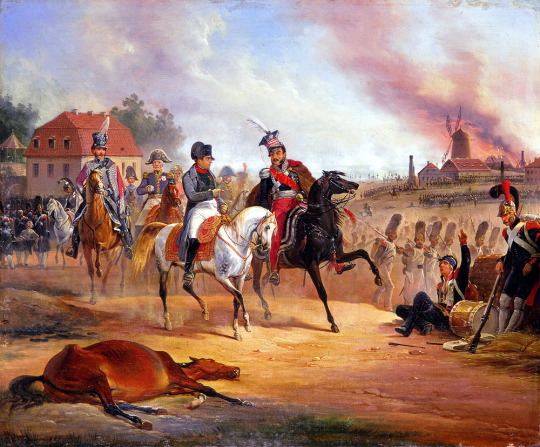
January Suchodolski, Napoleon and Józef Antoni Poniatowski at the Battle of Leipzig
On the morning of the last day of the battle, Polish troops were defending a section of the southern suburbs near the Peters Thor gate. Moreover, that time they had not only to fight the enemy, but also there intensified clashes with the locals, who were shooting at the retreating units from the windows.

Author Unknown, Prince Józef Poniatowski during the Battle of Leipzig
At about 11:00 Prince Józef found it impossible to conduct further defensive operations in this place and ordered a retreat. The Poles moved along the esplanade, where, near the Wasserkunst fountain, they fight the enemy in an organized manner for the last time.

Jan Chełmiński, Prince Józef Poniatowski at the head of the troops at Leipzig
During that skirmish Poniatowski was probably wounded (probably not first time). As Klemens Kołaczkowski recalled:
He received a wound in the hand from a rifle bullet; he ordered it to be treated, got back on the horse and, holding his hand on a scarf, he did not stop fighting.
Then the Poles, having left the city walls, were looking for a crossing. The first on their way was the Pleisse River, deprived of all bridges on Napoleon's orders. Kołaczkowski:
Prince Poniatowski <…> was exposed to the fire of enemy tirailleurs, in dense troops approaching from all sides. General Bronikowski, standing next to the prince, advised him to seek salvation by swimming. But the prince answered him quickly: "One must die bravely!" (Il faut mourir en brave - AS) He ordered the rest of the escort to attack enemy tirailleurs one more time, but that managed to stop their advance only for a moment. There was not a single moment to lose! In this last resort, the prince finally followed the opinion of the officers surrounding him, mounted his horse and jumped into the river with him!
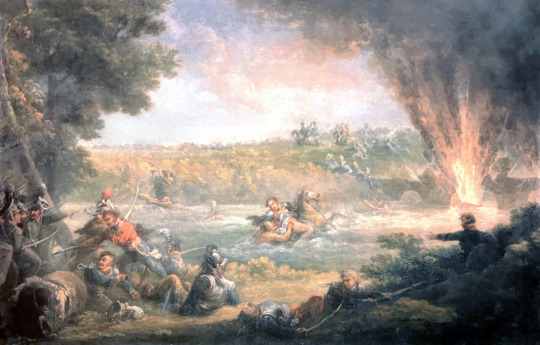
Jan Bogumił Plersch, Prince Poniatowski crossing Pleisse
The water was flooding the banks high up; the horse, carried away by its momentum, could not reach the shore. At this sight, captain Blechamps from the staff rushes after the prince, helps him swim and get to the opposite shore.
But there was one more river to cross – the Elster. Which had also been devoid of all its bridges except one. But even that one was earlier that day blown up by mistake when a significant part of the French were still on the other bank.
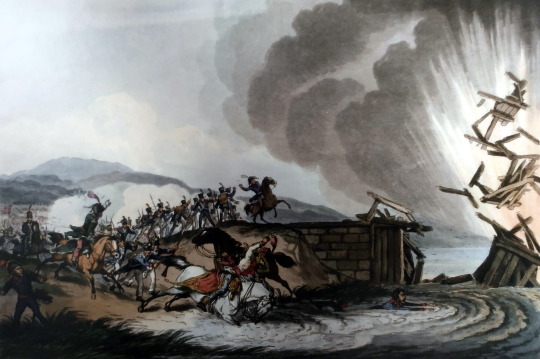
Retreat of the French from Leipzig, October 1813, an English engraving
What's more, in German Elster means "magpie". And according to legend, a gypsy woman once told Prince Joseph that he would die because of a magpie. And that's how it happened.

Tadeusz Korpal, Prince Poniatowski at Leipzig
Kołaczkowski:
The prince was walking on foot through the gardens lying between Elster and Pleisse: here, he was shot in the side by a rifle bullet for the second time and fell into the arms of the officers surrounding him. However, he soon regained consciousness and, with the help of his adjutant, mounted his horse with difficulty, swaying in the saddle. The Poles started to appeal to him to take care of himself and, handing over his command to another general, to preserve himself for the homeland. But the prince's courage seemed to increase with danger. "No! no!" he shouted "God has entrusted me with the honor of the Poles, I will only give it to God". The engineer's officer comes running and points to the most convenient place to cross; the prince, walking along the river bank, heads in that direction; but when he notices the enemy unit blocking his path, he shouts loudly: "There they are!" He turns his horse and rushes to Elster. Weakened by his wounds, he can no longer steer his horse, but the beast can only follow the current and cannot climb the high, precipitous shore. All this happened under a hail of bullets. At that final moment, the prince receives his third wound, slips from his horse and, carried away by the rush of the water, begins to sink. The good Blechamps comes to the aid again. In noble zeal, he throws himself into the river and grasps the prince. He was seen holding his arms and trying to lift the prince's head above the water, but the efforts of this noble man were in vain. They both disappeared forever in the currents of the treacherous river! Such was the death of a Polish hero, a beloved leader who preferred death to ignominious captivity.

Prince Poniatowski at Leipzig (enlarged)
According to another legend, at Leipzig prince Józef was to see the notorious White Lady of the Poniatowskis for the last time.
#józef poniatowski#poniatowski#1813#Leipzig#the battle of leipzig#napoleonic wars#napoleon bonaparte#Jan Czesław Moniuszko#Ludwik Braun#January Suchodolski#Jan Chełmiński#Jan Bogumił Plersch#Tadeusz Korpal
33 notes
·
View notes
Photo

Companions of Christmas 14: Hans Trapp!
Hans Trapp (once known as Hans Von Trotha) was a German knight in who, in the 1480s, forcibly took possession of a castle fortress that had belonged to a monastery. When the monastery protested, Hans dammed up the nearby river, first depriving the monastery and the town that surrounded it of water, then releasing the water all at once to flood and wreck the town.
Because of this, his generally defiant attitude to the church, and other attacks on the monks, he was excommunicated by the pope, and stripped of his courtly positions and made an outlaw by Emperor Maximilian I.
Losing his earthly position (as well as his heavenly one) drove Hans mad with, first, anger, and then despair, and he survived his outlawry by disguising himself as a scarecrow and falling upon unwary traveler unlucky enough to pass by the fields in which he had laid his trap. Thus he eked out an increasingly miserable existence by predatory cannibalism.
Eventually he found that children made the easiest targets, and this drew the attention of Santa, whose raison d'être is the protection of kids. Santa and Piet went to confront Hans; Piet used himself as bait to draw Hans out, and, when Hans revealed himself, the two North Polers captured him.
By this point, Hans was barely more than an animal, driven by fury and hatred and pain. Though confined, Hans was made comfortable, and Santa spent years working with him, drawing out the humanity that lay hidden inside the monster. First came Hans's reason, then something he'd never had, or at least never developed: empathy.
A contrite Hans knew that he could never undo the terrible things that he had done, but he could devote himself fully to using his knightly skills to prevent wrongs ever after. He is now the Guardian of the Pole; Santa has enemies, and Hans, who took a vow of silence in penance, ensures that none of them lay a finger on the man who showed him mercy and purpose, that Santa might forever continue to aid children without hindrance.
89 notes
·
View notes
Text
Were There Black People in Ancient & Medieval Europe?


Pescennius Niger, (A.D. 135-194), Roman emperor.
"In stature Niger was tall, in appearance attractive; and his hair grew back in a graceful way toward the crown of his head. His voice was so penetrating that when he spoke in the open he could be heard a thousand paces away, if the wind were not against him. His countenance was dignified and always somewhat ruddy; his neck was so black that many men say that he was called Niger on this account. The rest of his body, however, was very white and he was inclined to be fat."
"Now when the confusion in the state was at its height, inasmuch as it was made known that there were three several emperors, Septimius Severus, Pescennius Niger, and Clodius Albinus, the priest of the Delphic Apollo was asked which of them as emperor would prove of most profit to the state, whereupon, it is said, he gave voice to a Greek verse as follows:
"Best is the Dark One, the African good, but the worst is the White One."
And in this response, it was clearly understood that Niger was meant by the Dark One, Severus by the African, and Albinus by the White One. Thereupon the curiosity of the questioners was aroused, and they asked who would really win the empire. To this the priest replied with further verses somewhat as follows:
"Both of the Black and the White shall the life-blood be shed all untimely.
Empire over the world shall be held by the native of Carthage."
And then when the priest was asked who should succeed this man, he gave answer, it is said, with another Greek verse:
"He whom the dwellers above have called by the surname of Pius."
But this was altogether unintelligible until Bassianus took the name Antoninus, which was Pius' true surname. And when finally, they asked how long he should rule, the priest is said to have replied in Greek as follows:
"Surely with twice ten ships he will cleave the Italian waters,
Only let one of his barques bound o'er the plain of the sea.""
-Historia Augusta, Life of Pescennius Niger
"This proved to be the greatest disaster of the war; for twenty thousand of Niger's followers perished. And this evidently was the meaning of the priest's dream. It seems that while Severus was in Pannonia the priest of Jupiter in a dream saw a black man force his way into the emperor's camp and come to his death by violence; and by interpreting the name of Niger people recognized that he was the black man in question. Upon the capture of Antioch not long after this, Niger fled from there toward the Euphrates, intending to make his escape to the barbarians; but his pursuers overtook him and cut off his head. Severus caused the head to be sent to Byzantium and to be set up on a pole, that the sight of it might induce the Byzantines to join his cause. After this he proceeded to punish those who had belonged to Niger's party."
-Cassius Dio, Roman History, Epitome of Book LXXV
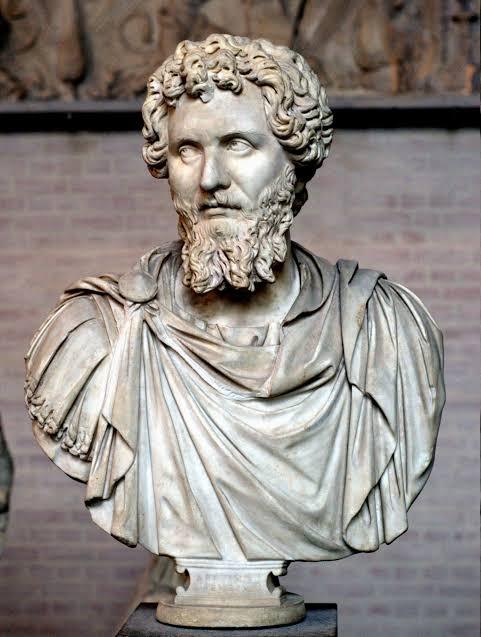

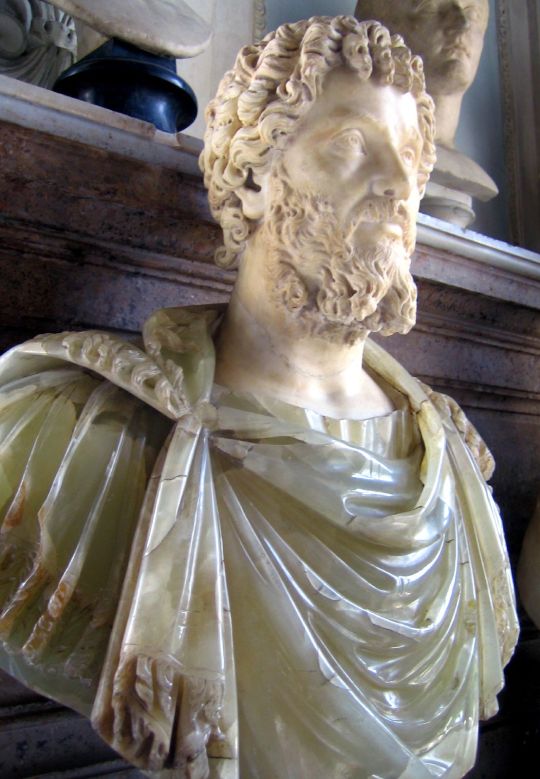
Septimius Severus, (C.E. 145-211), Roman politician and emperor, born in the city of Leptis Magna in Libya under Roman province in North Africa, and son of a Punic father and a Roman Italian mother.
Noted: He had rivalry with other Roman emperors, such as Pescennius Niger, during the Year of the Five Emperors.
When he was governor of Gaul, he married a Syrian-born Julia Domna, who was also an empress. The two bear two sons; Caracalla and Geta.
Septimius began his progress to become emperor by assassinated the dissolute ruler, Commodus in 192 C.E., but Pertinax immediately succeeded as emperor, which caused an enraged mutiny among the Praetorian Guards, and they assassinated him when he tried to bribe them. Didius Julianus proclaimed emperor when the throne put in auction to the highest bidder who is willing to pay the supporting of the Praetorian Guards. The Roman population was not happy at this scandalous affair, which eventually emerged an open challenge to Julianus's rule by three candidates. In this case, this started the Year of the Five Emperors.
In 195 C.E., Septimius gone to war with the Parthian Empire and claimed victory when conquered northern Mesopotamia.
While constructing his hometown Leptis Magna in Libya, the Roman frontier was attacked by Berber tribe, Garamantes. So, Septimius launched a campaign in northwestern Africa against them, drove them deep into the rural desert as he captured their capital. He also expanded more frontiers at that region.
Here is something interesting. While there are some resources of scholars concerning diversity in history and ancient civilization, especially when it comes to describing someone's physical appearance, there are some sources that Septimius Severus had a dark skin complexion. Some scholars denied his appearance even though there are unhidden facts that he could be a brownish skinned man. I, myself, can confirm that his complexion is dark, but not as dark as the color black. I can describe that his skin tone as the color of some furniture made of wood or describing what kind of shade his appearance is. I wouldn't know, honestly, nobody could be certain consider that he has mixed ancestry of Punic and Roman Italian. Let's get to the point. According to Historia Augusta, while Septimus expecting the construction progress of the wall of Luguvallum in Britain, he met an Ethiopian jester. He angrily ordered his men to remove from his sight. Septimius was probably disgusted by his garland fashion. The Ethiopian replied to him, by the way of jest, saying "You have been all things, you have conquered all things, now, O conqueror, be a god."
Here is something when it gets weird, when arriving in a town, he wished to perform a sacrifice as he is misunderstood on part of the rustic soothsayer, he was taken into the temple of Bellona, and, at other places, the victims were black. Septimus was disgusted at this, so he left and returned to the palace. He had the black victims be part of the attendants, followed him to the very doors, despite, however, he didn't care. You can read this part here, on passage 22.
Well, that's it for Septimus Severus, let's look up more persons.

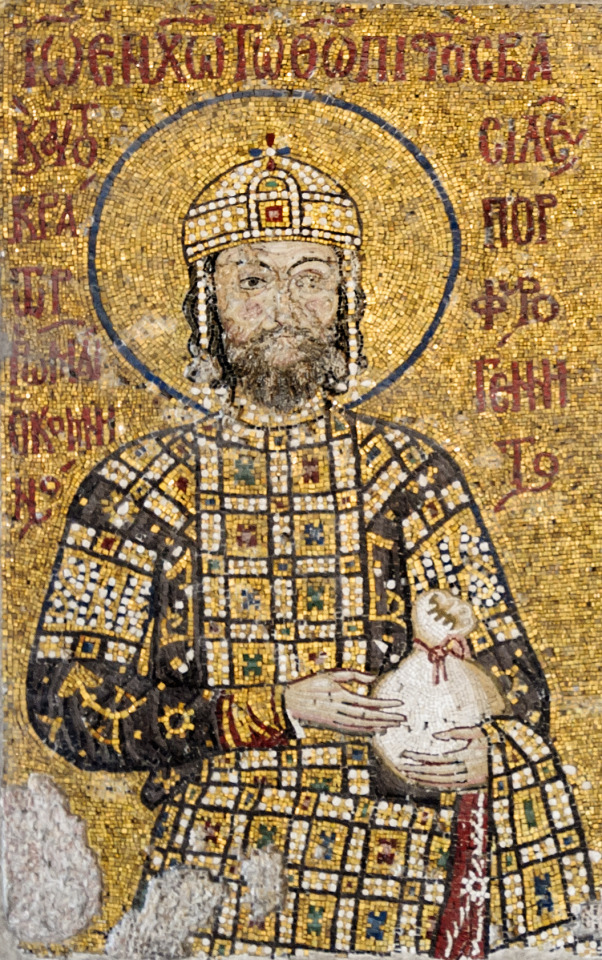
John II Komnenos, (C.E. 1087-1143), emperor of the Byzantine Empire (Eastern Roman Empire), son of Alexios I Komnenos and Irene Doukaina. His nickname: "the Handsome".
Here is some source of my research according to this:
John's nickname of "the handsome" and his general character is explained as follows by the historian J. J. Norwich: "Even his admirers admitted that he was physically ill-favoured, with hair and complexion so dark that he was known as 'the Moor'. He had, however, another nickname too: Kaloiannis, 'John the Beautiful'. This was not intended ironically; it referred not to his body, but to his soul. Levity he hated: luxury he frowned upon. Today most of us would find him an insufferable companion; in twelfth-century Byzantium he was loved. First of all, he was no hypocrite. He was genuine, his integrity complete. Second, there was a gentle, merciful side to his nature that in his day was rare indeed. He was generous, too: no Emperor ever dispensed charity with a more lavish hand." (266-7)
You can read these informations here.
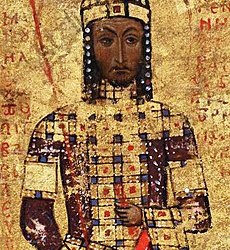

Manuel I Komnenos (C.E. 1118-1180), son of John II Komnenos and ruled the Byzantine Empire after his father.
In case you're wondering that woman on the right picture is his wife, Maria of Antioch.
As most people already knew that there were black people southern parts of Europe in the medieval era as there were in Ancient Greece and Rome, there should be evidence like archaeological material things that they contributed like every civilization in the world. If there are some ruins left over there, there should be written manuscripts and paintings on walls and vases. There should be some portrait paintings still laying in very old abandoned houses or castles. In this case, you would also find some Moorheads on the knight shields, flags, and on signs hanging above the entrance of taverns.

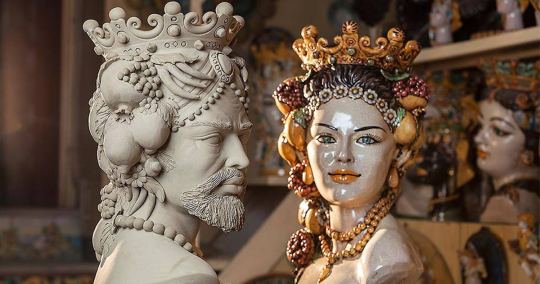

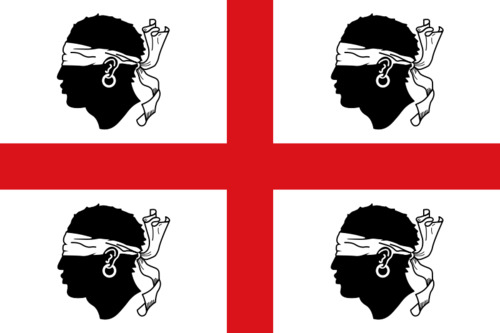
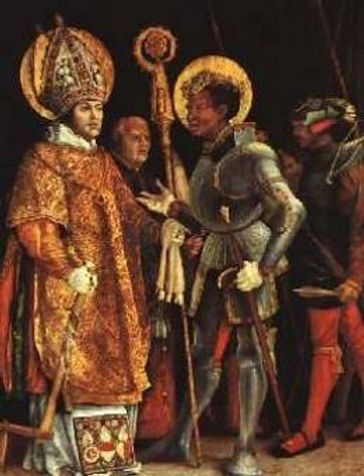
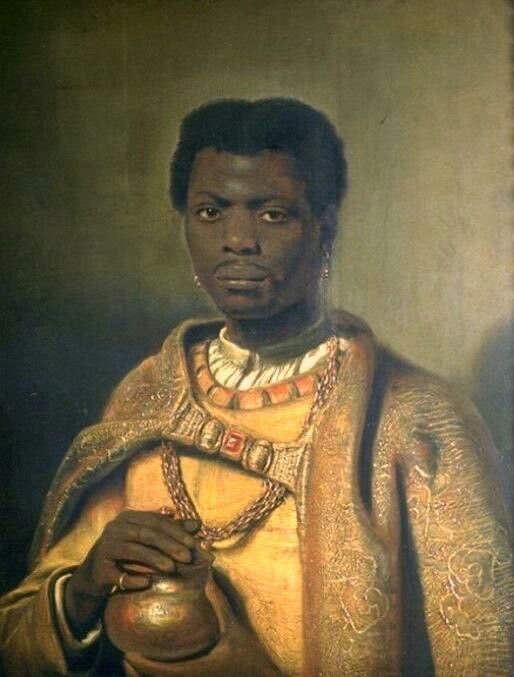
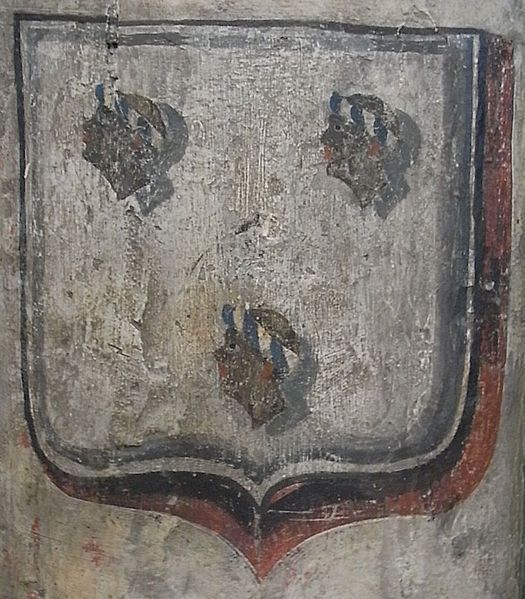

According to most historians concerning the medieval history of Spain and Portugal, the moors conquered Hispania in 711 C.E. and was probably the first region that ever conquered by them before Sicily as since these regions are to Northern Africa. Even this historical event is true, most people don’t believe the moors are black. When they think about moors, they think about Arabs and Muslims. Well, they’re right on that part, and I honestly don’t think that all moors are black, even I believe there were black people in medieval Europe, but there were black people among the moors and they could be called black moors. Moorish people could be comprised of multiple people from Northern Africa and Western Asia or Middle East. In the Moorish conquered lands of Europe, the population could be diverse, composed of Gothic tribes of the Germanic people (whom I believe they’re tribe of white people), Arabs, Berbers (Amazigh that they called themselves) Romans, Greeks, Jews, black moors or negroes.
I don’t think black people in the Middle Age never called themselves black, negroes, nor moors, such black is just color, it not a race, nation, or tribe. You should know that not everyone in Africa are not the same people consider it's just a continent. Same thing with Europe, especially in the Roman Empire as there were different ethnicities among this empire; most people there can trace their origin of their kind. Most blacks can trace their origin while some of them don’t. Probably they don't know who they really are. I can conclude that most of them can trace their origins outside being labeled as by other people, most of blacks believed they’re originated from Egypt, Libya, the Phoenicians, Jerusalem, and Arabia.
In what is now called the U.K., there could be most black people settled there. They were probably labeled as Dubh Galls or Black Gentiles by the Danes while the other locals were called Finn Galls or White Gentiles. Dubh Gall also means Dark Stranger in Gaelic, maybe refer to the Danes, but more generally lowlanders. While there were different clans of Vikings, the Danes seems to be the only clan outside the rest of them, to have dark complexion. Most of them might have mixed ancestry of both Finns and Dubhs. The Danes would be labeled as outsiders or strangers as they should be the ones being look upon.
Here is a page mentioning the Danes from the book The Black Foreigners of York and White Foreigners of Dublin by Alfred P. Smyth, part of Saga book of Viking Society, vol. 19:
"In 866 the “Great Army” of Danes crossed the Humber from its base in East Anglia and captured York on the feast of All Saints. Five months later, on 21 March 867, the Danes successfully repulsed a Northumbrian attempt to regain the city. In the battle-rout which ensued the Northumbrians lost both their kings, Osbert and Ælla, and the Danes became the undisputed masters of the kingdom. Contemporary Irish annalists described the Danish assailants at York and the slayers of King Alli, as Dub Gaill or “Black Foreigners”. These Dub Gaill were so called to distinguish them from their fellow vikings and rivals the Finn Gaill or “White Foreigners” – the name applied by Irish chroniclers to the Norwegian invaders who harassed their own shores.
It is clear from other references to Scandinavian activity of the ninth and tenth centuries within Ireland that the “White Foreigners” had a predominantly Norwegian origin, and that their opposite numbers were Danes. We know from the annals that the Finn Gaill had been established in Western Scotland and Ireland before the arrival of their Dub Gaill enemies, and Scandinavian sources, together with archaeological and place-name evidence, make it clear that the earliest settlers in the West were Norsemen. The oldest Irish source which actually equates the “Black Foreigners” with Danes is the twelfth-century War of the Irish with the Scandinavians (Cogadh Gaedhel re Gallaibh) which speaks of “Danish Black Gentiles” (Duibgeinti Danarda) who tried to drive the “White Gentiles” out of Ireland in 851."
There are some hidden mentions of Blacks or their names with the word, in most different languages, black in medieval Scotland such as Kenneth the Niger and James Douglas, who was also called Black Douglas.
"The little knowledge we have is chiefly from Barbour, who tells us he was a youth, ‘bot ane litill page,’ when his father was imprisoned. Barbour has also preserved a word-portrait of his hero. He was, it is said, of commanding stature, well formed, large-boned, and with broad shoulders; his countenance was somewhat dark or swarthy, but frank and and open, set off by locks of sable hue. Courteous in manner, wise in speech, though he spoke with a slight lisp, gentle in all his actions. Terrible in battle, and at all times an enemy to everything treacherous, dishonourable or false."
-The Good Sir James Douglas, k1330 (douglashistory.co.uk)
I thought about add this paragraph for St. Patrick Day, but I'm going to add a link for you to visit this website as I'm going to share my thoughts on this subject. I think most of the Irish or Celts were pale while there are some foreigners living among them, and I think the black people also settled there in Ireland after migrating from neighboring regions such Scotland, and Hispania.
"The term 'Black Irish' has commonly been in circulation among Irish emigrants and their descendants for centuries. As a subject of historical discussion the subject is almost never referred to in Ireland. There are a number of different claims as to the origin of the term, none of which are possible to prove or disprove. 'Black Irish' is often a description of people of Irish origin who had dark features, black hair, dark complexion and eyes."
-Black Irish - Who Were The Black Irish? (ireland-information.com)
Here's my conclusion: As I am fond of world history, but history tend to be hidden. There is truth, mystery, and lies in history as, despite all that, there are hidden evidence and information. As for the blacks or black moors in ancient Europe, I found it interesting as I already knew the origins of so-called black people which it also one of the things that make acknowledge of the world as it made me neutral. Most people believe in lies as they if they rather to live in the world of lies (which it is.). I know I would get some backlash from those who disagree or accuse me of being a bigot. To make this clear, I'm not stealing history and culture from anyone, nor lying in that matter, I just sharing some facts as I did my research. I also posted links containing with information, especially from historians and scholars. I can agree or disagree. I'm not proclaiming that all Europeans were black, even I believe there were blacks living among them. You can do your research on your own, and there are links on this topic. Well, that concluded my topic, and it was hard work but it's probably worth it.
#history#ancient history#world history#medieval history#black history#black history month#ancient greece#ancient rome#byzantine empire#ireland#scotland#u.k.#england#spain#moors#moorish#europe#truth#research#evidence#archaeology#ancient#north africa#ancient celts#vikings#roman empire
6 notes
·
View notes
Text
Drives me up the wall that when people talk about 1421: The Year China Discovered the World, they just laugh at the absurdity of China discovering the Americas in 1421.
Don't get me wrong, that's an extraordinary claim with extraordinarily poor evidence, but it's also one of the more sensible claims Gavin Menzies made in that book. Other assertions include:
The treasure voyage which reached the Americas also visited every continent except Europe and circumnavigated the globe, in three years
They returned to China by way of the Arctic Sea, visiting the North Pole along the way
China left colonies everywhere the treasure voyages went, only for those colonies to vanish when the Hongxi Emperor stopped the famous treasure fleets.
And then there's the sequel, 1434, which asserts that a Chinese treasure voyage "ignited" the Renaissance right after China famously stopped its treasure voyages and somewhere between 30-120 years after the Renaissance started. And that Zheng He's massive treasure ships got to Italy by way of a Nile/Red Sea canal which, in our world, wasn't used for ships since the 8th century or so and was mostly used for irrigation.
Menzies also says that Croatians used Chinese maps to sail to modern-day Virginia, specifically Roanoke. It's not clear whether he thinks these people became the Croatan tribe in the ~150 years between his cited date and the end of the Roanoke colony or if Menzies just doesn't know the simple and well-documented explanation for the Roanoke colony's fate. This isn't actually related to China igniting the Renaissance, but Menzies threw it in.
So yeah, "China colonized America" is small potatoes compared to all that.
3 notes
·
View notes
Note
Hi can u pls rant more abt the shuggy yinyang parallels?🙏 i never realized it but it fits well w them like holy crap❤️💙
The yinyang parallelism is so entrancing once you see it because it’s presented clearly in so many aspects of them, it’s like Oda deliberately reminds us of how polar opposite they are. The North Pole vs South Pole argument, their views on piracy, how they became Emperors, even their least favorite foods are each other’s color.
But that’s why they work. Despite their differences they work well together, and they wanted to stay and travel together after the crew separated.

They butt heads and can’t get along because they’re contrary forces, but that’s why they balance each other out. They are land and sea, the heavens and the earth (it’s said the Phoenix descended from the heavens, and it parallels to how Shanks ‘descended’ from Mariejois).
Yin is connected to stillness, Yang is connected to action/dynamism. Shanks remains rooted in the New World protecting the weak and waiting for Luffy, Buggy owns a delivery mercenary business which involves a lot of constant traffic between places and many people coming and going. Buggy exploits and robs small towns and weaklings, while Shanks protects them like a solid wall.
If we look at their current situation, it looks imbalanced with Shanks and his officers being strong, but his fleet being extremely weak, while Buggy and his original crew are weak while his subordinates are the ones that carry the business with their strength.
Shanks balances out Buggy’s cowardice and selfishness, Buggy balances out Shanks’ simplemindedness and naivety.
By themselves, Buggy would ravage the world and Shanks would overburden himself, and they need each other to keep themselves in check.
When the Phoenix(Yin) and Dragon(Yang) are balanced together they represent everlasting matrimony and harmony, but when they’re unbalanced it means chaos in the world.
Shuggy breakup literally caused discord in the world!
Looking at the events in the story, Shanks and Buggy tend to separate and reunite during major world events. After Roger’s execution, the world was plunged into chaos and started the Pirate era. They reunited at the end of Marineford, where Shanks returned things back to their normal peace and put an end to the fighting. After that event, more chaos rose from Whitebeard’s death and declaration that the One Piece is real. Once we see Shanks and Buggy together in the present again, maybe that’ll truly signal the coming time for peace.
19 notes
·
View notes